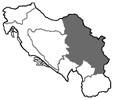
|
The Society of Folk Dance Historians (SFDH)
The Kolo
[
Home |
About |
Encyclopedia | CLICK AN IMAGE TO ENLARGE |

|
 Yugoslavia, located in the heart of the Balkans, is rich in folk art traditions – among which are the folk dances representing the heart of the people. These dances have been greatly influenced down through the ages by the many conquerors of this land. They also reflect the flavor of the countries surrounding its borders.
Yugoslavia, located in the heart of the Balkans, is rich in folk art traditions – among which are the folk dances representing the heart of the people. These dances have been greatly influenced down through the ages by the many conquerors of this land. They also reflect the flavor of the countries surrounding its borders.
The most popular form of folk dancing is the kolo, in which the dancers form a large circle and dance to the accompaniment of singing or musical instrument, of which the most widely used is the shepherd's flute and the Turkish drum. There is a great variety in the style of dances depending on the characteristics peculiar to the region from which they originate. The dances can be interpreted as ritual, heroic, humorous, mimicking, emotional, sentimental, or just plain happy dances for social occasions.
The "ritual" dances are among the oldest type dances and are identified with celebrations and customs, such as weddings, harvesting, or religious holidays. Among the best known and most interesting type of dances are the Rusalije, a sword dance that shows off the dancer as a heroic character; Lindjo, danced to the commands of a leader; a silent kolo, with no musical accompaniment; or Green George, involving singing and dancing to celebrate the festival of youth and greenness.
Many of these Kolo dances are still done today on special occasions. In fact, it is safe to say that whenever and wherever the Yugoslav people get together to make merry – the Kolo is danced.
DOCUMENTS
- Kolo, Some Background, an article.
- Kolo Lines, an article.
- Something About Kolos, an article.
- Yugoslavia, a former country.
This article by Rubi Vučeta appeared in the 1969 brochure for The Intersection,
a Los Angeles, California, folk dance coffeehouse where folk dancing
and international music occurred seven nights a week.
This page © 2018 by Ron Houston.
Please do not copy any part of this page without including this copyright notice.
Please do not copy small portions out of context.
Please do not copy large portions without permission from Ron Houston.